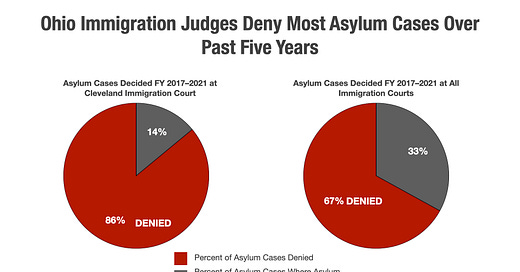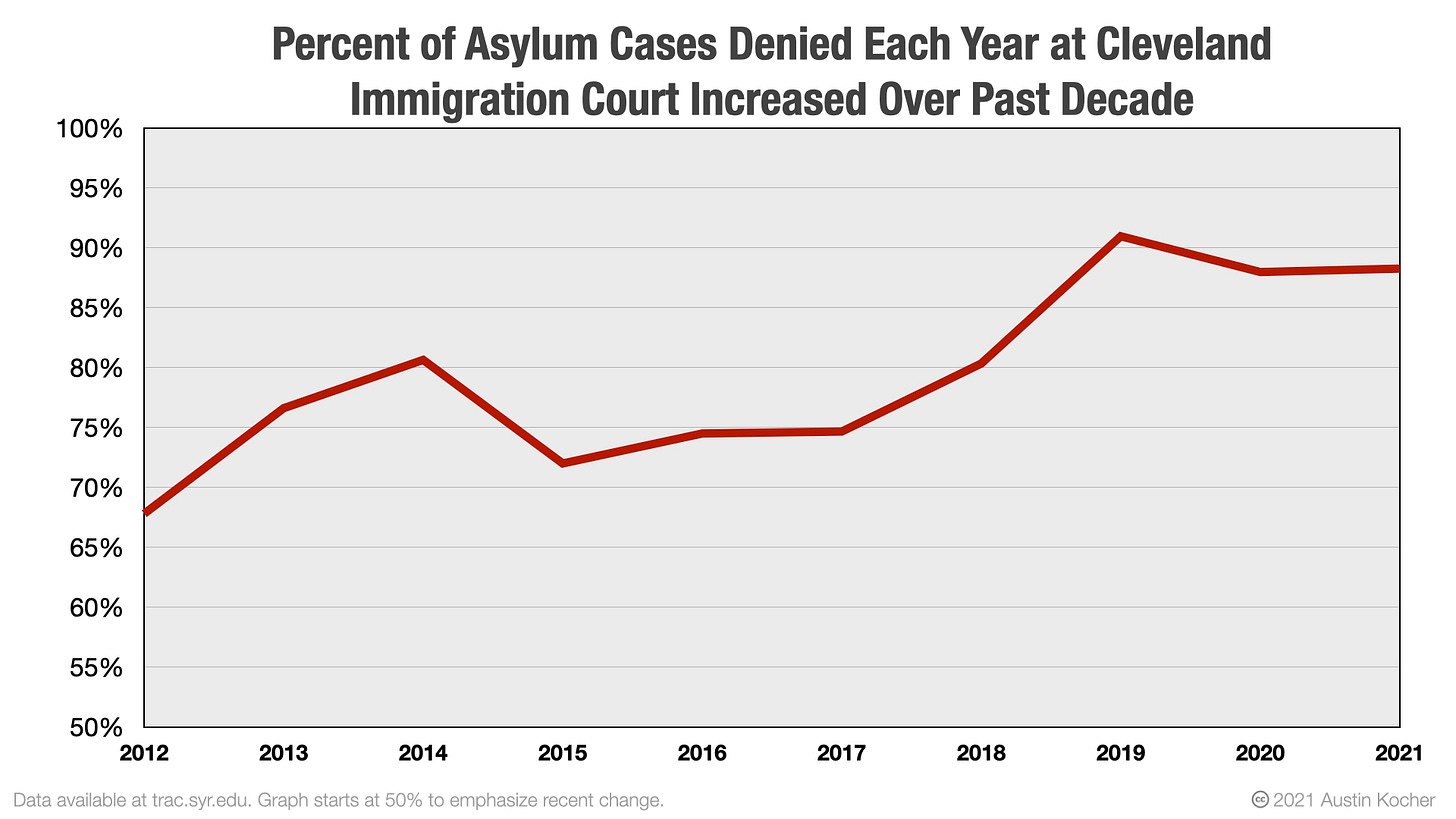Even though immigration policy tends to focus on the U.S.-Mexico border asylum, it may come as a surprise that one of the most difficult places to obtain asylum is at the Cleveland immigration court in Ohio, far from the Southern border.
Most people don’t think of immigration and Ohio in the same sentence. But as an Ohio native myself who spent years studying immigration in my home state, I have seen first-hand how immigrants have become important to the social life and economy of Ohio. Alongside a growth in immigration, however, there has also been a growth in the number of people who are facing deportation. These new findings about the high rates of asylum denial at the Cleveland immigration court, as well as the additional data from our research below, provide insight into how national immigration policy plays out at the state and local levels.
New data from the Transactional Records Access Clearinghouse (TRAC) at Syracuse University shows that 88% of asylum cases decided by immigration judges in Cleveland, Ohio in FY 2021 have been denied, and just 12% of applicants have received asylum or another form of protection. This is much higher than the national average where 63% of asylum cases have been denied. TRAC’s data also show that the asylum denial rate has increased from around 67% a decade ago.
Additional data about the Cleveland immigration court updated through the end of September 2021 (the end of the government’s fiscal year) can be found below. The Transactional Records Access Clearinghouse (TRAC) is a non-partisan academic research institute at Syracuse University that studies the federal government.
New Deportation Cases
In FY 2021, the immigration court in Cleveland, Ohio has received 2,816 new deportation cases. People from Honduras made up the largest group of cases with 466 new cases filed, followed by cases involving people from Guatemala (458), Venezuela (252), Brazil (250), and Mexico (196) (See data here.)
Immigration Court Backlog
A total of 14,963 deportation cases are currently pending at the Cleveland immigration court. (See data here.)
The backlog of deportation cases in Ohio doubled f since the start of the Trump administration when between 6,000 and 7,000 cases were pending. (See data here.)
Across Ohio, Franklin County (Columbus) has more immigrants currently facing deportation than any other county in the state with 4,152 pending cases. Hamilton County (Cincinnati) has 3,277 pending cases, and Cuyahoga County (Cleveland) has 1,083 pending cases.
Less than one in five (17%) immigrants in Ohio with new deportation cases filed in the past 90 days have an attorney. (See data here.)
Outcome of Asylum Cases
Immigration judges in Cleveland have completed 375 asylum cases so far in FY 2021. Last year, in FY 2020, they completed 624. (See data here.)
Immigration judges have denied 80% of all asylum applications in FY 2021. This is significantly higher than the national average. (See data here.)
The asylum denial rate at the Cleveland immigration court has exceeded the national average for years. The denial rate increased steadily from 72% in FY 2015 and has hovered around 90% for the past three years.
Immigration judges at the nearby Detroit immigration court denied far fewer asylum cases (60%) compared to Cleveland.
Bond Hearings
In FY 2021, immigration judges in Cleveland have denied bond in 82% of the 119 bond hearings completed so far. This is higher than the previous year when, in FY 2020, immigration judges denied 55% of 426 bond hearings. (See data here.)
Quick note: if you like getting short updates on immigration data, policy, and news, please help me get the word out by sharing this newsletter online or with friends and colleagues. I’m passionate about making the complex immigration system more intelligible for more people and doing it using a non-partisan, academic approach. Thank you!






As an Ohioan currently studying immigration law (via the VIISTA program), I sincerely appreciate these stats. My biggest question is why is it so difficult to obtain legal representation in Ohio for asylum seekers? I want to help out as an accredited representative, but I'm not finding opportunities in my area (Toledo) to do so. There's got to be a lot more going on beneath the surface for these horrible denial rates to make sense.
Austin, are there avenues through which to formally investigate the Cleveland court? Whereby they would have to justify these numbers?